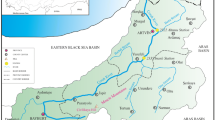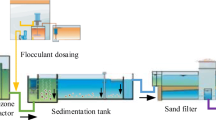Abstract
The three-dimensional (3D) fractal dimension is an important parameter to analyze the 3D structure and flocculation effect of the hematite flocs. In this work, the 3D fractal dimension of hematite flocs was predicted by establishing the particle swarm optimization (PSO) algorithm optimized with the back propagation (BP) neural network (PSO-BP). The proposed model considers four factors, namely, the flocculant quantity, flocculation time, stirring speed, and temperature, as the input parameters. We normalize the input data during the preprocessing stage. The BP neural network was optimized by using the PSO algorithm for realizing the 3D fractal dimension. The prediction accuracy and effectiveness of the model were evaluated. The experimental results showed that the predictions performed by the proposed PSO-BP neural network were better than that of BP neural network. In addition, the root mean square error (RMSE), mean squared relative error (MSRE), mean absolute error (MAE), and mean absolute relative error (MARE) of the proposed model are lower, compared with the errors of the BP network. Similarly, the measurement coefficient R2 of the proposed model is higher, compared with the BP network. The maximum absolute error of the model is 0.0772, the maximum relative error is 0.02405, and the regression coefficient r is 0.98592. These results showed that the proposed model has a good performance and high prediction accuracy. When verifying the practicability and the effectiveness of the proposed PSO-BP model, the prediction results of 10 groups of hematite flocculation experimental data under different conditions showed that the prediction value of the proposed PSO-BP model was closer to the ground truth as compared to the BP model. Therefore, the proposed model is suitable for predicting the 3D fractal dimension of hematite flocculation.













Similar content being viewed by others
References
Tian J, Gao H, Guan J, Ren Z (2017) Modified floc-flotation in fine sericite flotation using polymethylhydrosiloxane. Sep Purif Technol 174:439–444
Zhang T, Qin W, Yang C, Huang S (2014) Floc flotation of marmatite fines in aqueous suspensions induced by butyl xanthate and ammonium dibutyl dithiophosphate. Trans Nonferrous Met Soc China 24(5):1578–1586
Fox JM, Hill PS, Ogston AS et al (2004) Floc fraction in the waters Po River prodelta. Cont Shelf Res 24(15):1699–1715
Li T, Zhu Z, Wang DS et al (2007) The strength and fractal dimension characteristics of alum–kaolin flocs. Int J Miner Process 82(1):23–29
Son M, Hsu TJ (2009) The effect of variable yield strength and variable fractal dimension on flocculation of cohesive sediment. Water Res 43:3582–3592
Zhao J, Fu X, Wang J et al (2016) Effect of shear force field on the separation effect of ultra-clean coal based on fractal dimension of flocs. J China Coal Soc 41(8):2078–2085
Wei W, Du M, Zhu J et al (2014) Multifractal behavior of flocs growth in flocculation processes. Acta Sci Circum 34(1):79–84
Berrezueta E, Cuervas-Mons J, Rodríguez-Rey Á, Ordóñez-Casado B (2019) Representativity of 2D shape parameters for mineral particles in quantitative petrography. Minerals 9(12):768
Vojislav M, Cristina S, Ivana I, Markus M, HansJörg F (2021) Fractal nature of advanced Ni-based superalloys solidified on board the International Space Station. Remote Sensing 13(9):1724
Xi Z, Wang J, Hu J, Tang S, Xiao H, Zhang Z, Xing Y (2018) Experimental investigation of evolution of pore structure in Longmaxi marine shale using an anhydrous pyrolysis technique. Minerals 8(6):226
Fu H, Li H (2020) Prediction model of air pollution index in Anyang City in winter based on BP neural network. World Sci Res J 6(10):265–275
Han I, Yuan T, Lee J, Yoon Y, Kim J (2019) Learned prediction of compressive strength of GGBFS concrete using hybrid artificial neural network models. Materials 12(22):3708
Xu Z, Ye D, Chen J, Zhou H (2020) Novel terahertz nondestructive method for measuring the thickness of thin oxide scale using different hybrid machine learning models. Coatings 10(9):805
Wang Q (2020) Application of BP neural network model in data analysis. Electron Technol Softw Eng 12:189–190
Chen J, Hsieh H, Do Q (2014) Forecasting Hoabinh reservoir’s incoming flow: an application of neural networks with the Cuckoo Search algorithm. Information 5(4):570–586
Zhang L, Wang F, Sun T, Xu B (2018) A constrained optimization method based on BP neural network. Neural Comput Appl 29:413–421
Deng C, Feng Y, Shu J, Huang Z, Tang Q (2020) Prediction of tool point frequency response functions within machine tool work volume considering the position and feed direction dependence. Symmetry 12(7):1073
Hossain Lipu MS, Hannan MA, Hussain A, Saad MHM (2017) Optimal BP neural network algorithm for state of charge estimation of lithium-ion battery using PSO with PCA feature selection. J Renew Sustain Energy 9(6):1063
Chen N, Xiong C, Du W, Wang C, Lin X, Chen Z (2019) An improved genetic algorithm coupling a back-propagation neural network model (IGA-BPNN) for water-level predictions. Water 11(9):1795
Xiang T, Wang H (2018) Research on distributed 5G signal coverage detection algorithm based on PSO-BP-kriging. Sensors (Basel, Switzerland) 18(12):4390
Parsopoulos KE, Vrahatis MN (2002) Recent approaches to global optimization problems through Particle Swarm Optimization. Nat Comput 1:235–306
Zhan X (2022) Construction of TCM syndrome prediction model for psoriasis based on PSO-BP. Mod Comput 28(06):52–55
Gao M, Yu S, Zheng J, Xu C, Liu W, Luan H (2016) Research on resistivity imaging using neural network based on immune genetic algorithm. Chin J Geophys 59(11):4372–4382
Amar MN, Zeraibi N, Redouane K (2018) Bottom hole pressure estimation using hybridization neural networks and grey wolves optimization. Petroleum 4(4):419–429
Eberhart R, Kennedy J (1995) A new optimizer using particle swarm theory. MHS’95. Proc Sixth Int Symp Micro Mach Hum Sci 10(6):39–43
Liu X, Liu Z, Liang Z, Zhu S, Correia JAFO, De Jesus AMP (2019) PSO-BP neural network-based strain prediction of wind turbine blades. Materials 12(12):1889
Shao D, Nong X, Tan X, Chen S, Xu B, Hu N (2018) Daily water quality forecast of the south-to-north water diversion project of China based on the Cuckoo Search-back propagation neural network. Water 10(10):1471
Poli R, Kennedy J, Blackwell T (2007) Particle swarm optimization. Swarm Intell 1:33–57
Kshirsagar P, Akojwar S (2016) Optimization of BPNN parameters using PSO for EEG signals. Proc Int Conf Commun Signal Process 2016 (ICCASP 2016) 12:384–393
Jin C, Jin S, Qin L (2012) Attribute selection method based on a hybrid BPNN and PSO algorithms. Appl Soft Comput J 12(8):2147–2155
Funding
This work is financially supported by the National Natural Science Foundation of China (51874135, 51904106), Natural Science Foundation of Hebei Province (E2019209347), and Tangshan Basic Innovation Team Project (19130207C).
Author information
Authors and Affiliations
Contributions
Conceptualization, H.Z. and F.N.; investigation, H.Z., F.N., and J.Z.; methodology, H.Z. and X.Y.; formal analysis, J.Z. and X.Y.; data curation, H.Z., F.N., J.Z., and X.Y.; writing—original draft preparation, H.Z. and J.Z.; writing—review and editing, F.N., J.Z., and X.Y.; project administration, F.N. and J.Z.; funding acquisition, F.N.
Corresponding author
Ethics declarations
Conflict of Interest
The authors declare no competing interests.
Additional information
Publisher's Note
Springer Nature remains neutral with regard to jurisdictional claims in published maps and institutional affiliations.
Rights and permissions
Springer Nature or its licensor holds exclusive rights to this article under a publishing agreement with the author(s) or other rightsholder(s); author self-archiving of the accepted manuscript version of this article is solely governed by the terms of such publishing agreement and applicable law.
About this article
Cite this article
Zhang, H., Niu, F., Zhang, J. et al. Prediction of Three-Dimensional Fractal Dimension of Hematite Flocs Based on Particle Swarm Optimization Optimized Back Propagation Neural Network. Mining, Metallurgy & Exploration 39, 2503–2515 (2022). https://doi.org/10.1007/s42461-022-00684-z
Received:
Accepted:
Published:
Issue Date:
DOI: https://doi.org/10.1007/s42461-022-00684-z




